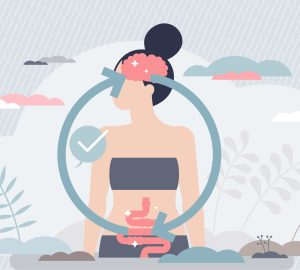Advances in health, wellness and self-care make it clear how many of us strive to better ourselves and the world around us. Whether it’s finding ways to stop the spread of disease, creating tools to teach the health care workers of tomorrow or simply looking for more sustainable ways to improve our routines, breakthroughs and new innovations are made every day.
teaching a new generation
Like most areas of modern life, technology shapes the way nursing students are taught and trained. It also has impacted the way they solve problems but not necessarily in a positive way, according to Cynthia Rubbelke, M.Ed., M.S.N.(R), RN, the e-technology coordinator for Saint Louis University’s Trudy Busch Valentine School of Nursing. “With so much technology at our fingertips, it’s easy to learn to just look things up instead of critically thinking about a problem,” she says. “Tech is a great resource, but just because it can help you find an easy answer doesn’t mean it’s always the right one.”
To help nursing students develop critical thinking skills, Rubbelke is working to change how they interact with smart phones and computers as research tools. She’s designed a prototype app to prepare them for the National Council Licensure Examination (NCLEX), a test required to become a registered nurse. The NCLEX is developing a new, progressive question format, which consists of case studies that unfold to test clinical judgement. “Questions include real-world scenarios, and students are given resources like lab results and charts,” she explains. “They must determine how they will care for patients.” The format won’t be implemented until 2023, but Rubbelke is using it as the basis for her app.
While she is still developing the prototype alongside two nursing professors, the idea is for students to start using the app their sophomore year. “That’s when they start their clinical courses and see what they’re going to be doing as nurses,” Rubbelke says. “We hope to take the theory they’ve learned and bridge it to the practice content.”
fighting COVID-19
Local researchers have been involved in several important studies dedicated to ending the pandemic. Both Washington University and Saint Louis University are testing vaccines for the virus. At SLU, participants recently began enrolling in a phase 3 trial for a vaccine co-developed by Moderna and the National Institute of Allergy and Infectious Diseases Vaccine Research Center. Researchers will evaluate the effect of the vaccine in adults with no known history of infection. “A safe and effective vaccine that will protect against COVID-19 is our best hope for ending the current pandemic,” says Dr. Sharon Frey, clinical director of SLU’s Center for Vaccine Development and principal investigator.
Along with vaccine research, there have been many key studies of treatment options. Earlier this month, researchers at Washington University School of Medicine began investigating whether ravulizumab, an FDA-approved treatment for rare genetic diseases, could help critically ill patients with the virus. The drug is a monoclonal antibody that inhibits part of the immune system known as the complement system. “There is evidence that activation of the complement system is at least partially responsible for some of the organ damage we see in COVID-19 patients,” says Dr. Hrishikesh Kulkarni, principal investigator and an assistant professor in the division of pulmonary and critical care medicine. “We believe blocking this activation is a viable approach to investigate.”
thinking blue
It’s always important to think about how we can make our skin care and makeup routines more sustainable, and the latest movement in eco-friendly beauty is looking to the ocean for inspiration. Blue beauty wants to ensure brands create products that are safe for the environment, which means sustainably sourced ingredients, minimized carbon footprints and limited plastic waste. Every year, millions of tons of plastic ends up in the ocean, including non-recyclable cosmetics packaging. Chemical ingredients in personal care products and makeup can have further negative impacts on wildlife.
Here are some steps you can take to think blue and reduce your impact on the environment:
- Look for cosmetics with refillable or reusable packaging.
- Choose brands that offer their own recycling initiatives. Some will ask customers to return plastic packaging, so they can recycle and reuse it.
- Find brands that use post-consumer plastics (PCR). This means they are using materials collected in commercial and residential
recycling programs. - Carefully consider ingredients. Many of us know that oxybenzone and octinoxate in sunscreen can harm coral reefs, but we don’t think about synthetic fragrances and silicones in products like shampoo, shaving cream, deodorant, makeup and even soap that get washed down the drain daily.
Sources: Elle, Vogue
treating cancer
Last month, Mercy Hospital broke ground on a new addition to bring proton therapy to its David C. Pratt Cancer Center. There are only 37 proton centers in the United States, and Mercy will be the second in Missouri after Siteman Cancer Center. The treatment works by using a high-energy beam of protons to precisely deliver radiation to a tumor. “It has less impact on normal tissue than other forms of radiation,” explains Dr. Robert Frazier, division chief of radiation oncology at Mercy. “This lessens side effects and causes fewer long-term impacts.”
While proton therapy isn’t a new concept, Fraizer says there have been several important developments in the field. New technology has led to the creation of smaller, more accessible treatment units, which can be used to treat more types of cancer. “In the past, it was primarily used for pediatric patients and some brain tumors,” he notes. “Now, proton therapy is an option for most patients. It can treat cancers like head and neck, lung, breast, prostate, and soft tissue sarcomas or tumors in bones.”
New technological developments also have made the therapy more accurate. “We can now modulate the proton beam, which means the intensity can be adjusted,” Frazier notes. “Another unique innovation is specialized imaging equipment that can be attached to the unit. During treatment, you can ensure that you are delivering the proton beam to exactly the right area.”
creating hope for alzheimer’s
An Alzheimer’s disease diagnosis often comes after issues like memory loss and confusion emerge. But the disease actually can start two decades or more before symptoms arise, as plaques of a sticky protein called amyloid form in the brain. These plaques can be found using positron emission tomography (PET) scans, according to Nicolas Barthelemy, Ph.D., an instructor in neurology at Washington University School of Medicine. “Unfortunately, it’s very expensive and not a viable option for mass screening,” he notes. New research suggests a more cost-effective alternative.
Barthelemy is first author on a study about the presence of a different Alzheimer’s protein, tau, in blood. Certain forms of tau had previously been discovered in cerebrospinal fluid (CSF) of people with amyloid plaques. However, testing CSF requires an invasive spinal tap, which patients may be reluctant to undergo. “We found a modification of tau was traceable in CFS up to 20 years before Alzheimer’s symptoms manifest,” he says. “We designed a study to find if the protein appears in blood in the same way.” By analyzing brain scans and using mass spectrometry to measure different forms of tau in blood samples, the research team found that one variation correlated with the presence of amyloid plaques.
The findings could help lead to the development of a blood test for Alzhiemer’s, which would revolutionize screening for the disease and also could help with developing more effective treatments. “Currently, all drug testing for Alzheimer’s is done on patients with clinical symptoms,” Barthelemy says. “Unfortunately, almost all of these trials fail to produce any benefit, but it’s possible that introducing intervention earlier in the disease’s progression could be more effective. A blood test could be a tool for recruiting asymptomatic participants and testing how therapies can slow or reverse the process.”
protecting your skin
Like blue beauty, the term anti-pollution skin care probably makes you think of sustainable cosmetics and saving the environment, but these products are all about defending your skin. According to the World Health Organization, more than 90% of the world’s population lives in places where the air contains high levels of pollutants. Like sunscreen protects from UV rays, anti-pollution skin care is designed to create a barrier to protect your face from exposure and its effects, such as wrinkles, pigmentation, breakouts and more.
The term is not regulated, so it’s important to know what ingredients are in the products you’re using. Something that isn’t labelled “anti-pollution” may give you better benefits than something that is; it just depends on their formulas. Here are some pollution-fighting ingredients to look out for:
- Vitamins C and E
- Algae
- Niacinamide
- Ceramide 3
- Prebiotics
- Green tea
- Zinc oxide and other mineral barrier
Sources: Harper’s Bazaar, Huffington Post








